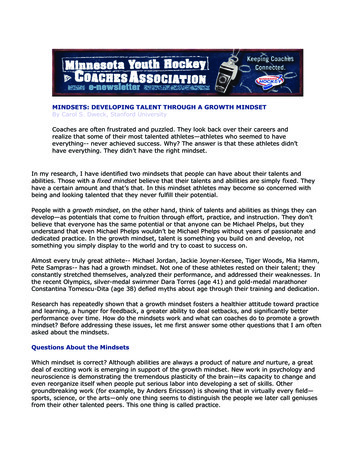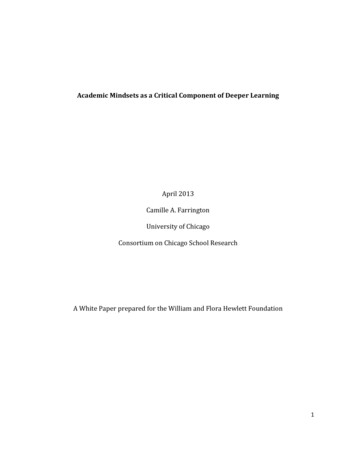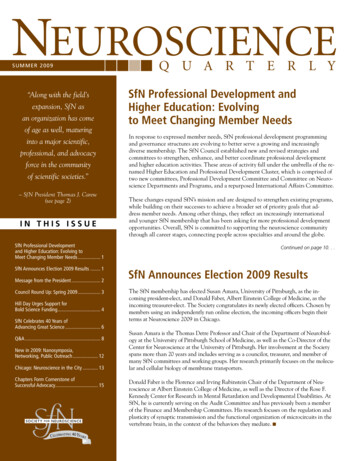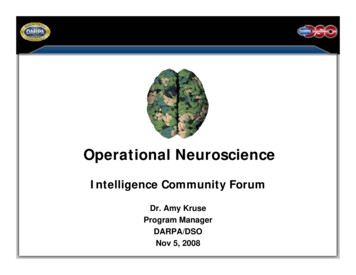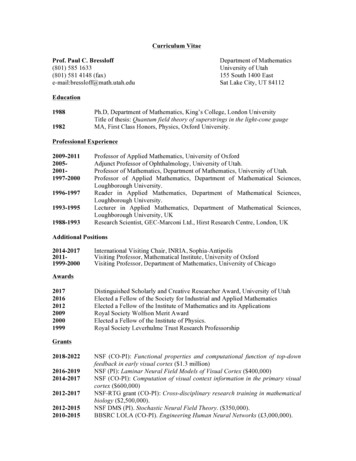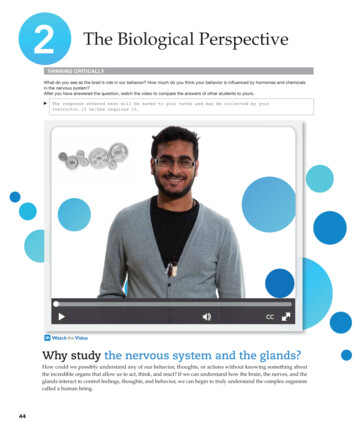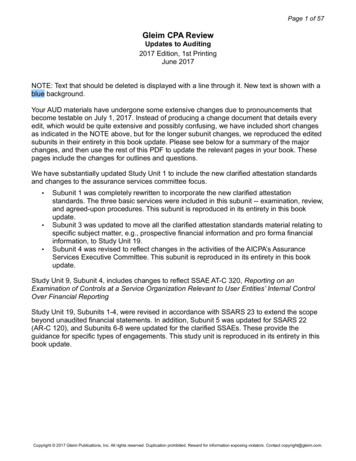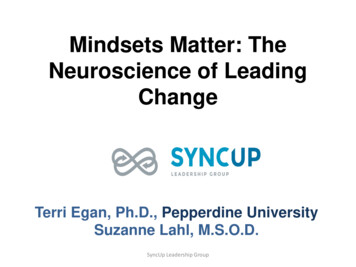
Transcription
Mindsets Matter: TheNeuroscience of LeadingChangeTerri Egan, Ph.D., Pepperdine UniversitySuzanne Lahl, M.S.O.D.SyncUp Leadership Group
Mindsets Matter Workshop Examines neuroscience behind thetendency to “go with what you know” Presents ways to grow agile mindsetsfor change in fast-paced, complexenvironmentsSyncUp Leadership Group
MindTriangle of WellBeing – 3 aspectsof energy andinformation flowBrainRelationshipsDr. Dan Siegel 2010
Dr. Dan Siegel – MINDSIGHT, 2010 , pg. 15
What do we mean byMINDSET?Our habits of mind, bothconscious and unconscious,that shape our reactions andbehavior.For better and for worse.SyncUp Leadership Group
SyncUp Leadership Group
What’s Above & Below TheWaterline?ConsciousUnconsciousSyncUp Leadership Group
How We Think We Lead ChangeConsciousUnconsciousSyncUp Leadership Group
How We Think People Reactto Up Leadership Group
The Reality: We Are ternsuntapped potentialdrivesemotionshabitsUnconsciousSyncUp Leadership Group
Over 90% of ourbehavior is drivenby fs and habits.SyncUp Leadership Group
No surprise that sustainablechange is elusive.SyncUp Leadership Group
Our mindsets areunderdeveloped andoverwhelmed.SyncUp Leadership Group
The ChallengeOur brain is wired to lovesimilarity,stability,securityOur brainis wiredto loveandnovelty onour ownstabilityterms. &simplicity,similarity,security.SyncUp Leadership Group
Complex Environments are Fullof Wicked ProblemsSyncUp Leadership Group
All LEAN activities areimpacted byMINDSETS.SyncUp Leadership Group
Could mindset growthstrengthen the foundation ofLEAN transformation?Lean Enterprise Institute
HABITS of MINDWhat’s the LEAN process foreliminating non-value addedhabits of mind?SyncUp Leadership Group
Solution:NEUROPLASTICITYSyncUp Leadership Group
How Do We Grow Our Mindset?DesireEducationApplied LearningRapid PrototypingDataSyncUp Leadership Group
The SyncUp4 Model forDeveloping MindsetsSyncUp Leadership Group
Step 1: Use your attention tochange your brain, reclaimfocus and build relationshipsDynamicAttentionSyncUp Leadership Group
Brain Power Inquiry1 almost never and 5 almost always I schedule my most complex taskswhen I am alert. I have a strategy for reducing anxietywhen I am under pressure. I regularly unplug from technology torecharge myself. I refrain from multi-tasking.SyncUp Leadership Group
SyncUp Leadership Group
SyncUp Leadership Group
SyncUp Leadership Group
The Neuroscience of DynamicAttentionMindful awareness changes thebrain, boosts immunity & increaseswell being.Multitasking as an act of arrogance.Your prefrontal cortex (executivefunction) is fragile.SyncUp Leadership Group
One action I will take toincrease: my own dynamic attention dynamic attention for myteam/groupSyncUp Leadership Group
Step 2: Use the power ofemotions, inspiration, intuition,and health to thrive as a LEANleaderWholePersonIntegrationSyncUp Leadership Group
S-P-I-N-E otionalSyncUp Leadership Group
Whole Person Inquiry1 almost never & 5 almost alwaysS - I feel part of a community at work.P - I use the signals my body sends me asinformation to change my behavior.I - I regularly challenge my own thinking.N - I count on my intuition to help me makedecisions.E - I process emotions to gain insight.SyncUp Leadership Group
Whole Person (SPINE)ReflectionWhat do Ivalue, what doI ignore?SyncUp Leadership Group
SpiritualSense of meaning, purpose &community at work.SyncUp Leadership Group
PhysicalManage well being & energy,use body as signaling system.SyncUp Leadership Group
IntellectualComfort with complexity andambiguity – systems thinker.SyncUp Leadership Group
iNtuitiveSee patterns in unrelated data;source of creativity and insight.SyncUp Leadership Group
EmotionalRecognize emotions asinformation, regulate emotions,attune to self and others.SyncUp Leadership Group
Emotions Drive BehaviorBecause thinking serves at thepleasure of emotion, emotionalmaturation provides the foundationfor the quantum leap from intelligenceto wisdom.Louis John "Lou" Cozolino, Ph.D.Professor of Psychology, Pepperdine UniversitySyncUp Leadership Group
SyncUp Leadership Group
SPINE Integration Impact– Feeling connected to self and others– Focus– Resilience– Accountability– Tolerate ambiguity– Regulate emotions– Agile– Well-beingSiegel, (2010)SyncUp Leadership Group
Step 3: Step back, assess thesituation, incorporate newinsights and take action.StrategicClaritySyncUp Leadership Group
Remember .More than 90%of whatmotivates usis under thewaterline.SyncUp Leadership Group
Leadership Behavior PatternsPick one pattern that describes you: Works hard Maintains high standards Action oriented Takes strong stands Seeks harmonySyncUp Leadership Group
The Case of Helen‘Works Hard’ PatternSERVE others nomatter whatLack of EMPATHY forself and othersSyncUp Leadership Group
The Neuroscience ofStrategic ClarityWe have 100’s of biases thatoperate automatically.Understanding how your mind andbrain interact can help you mitigatethose biases.SyncUp Leadership Group
What Fires Together Wires TogetherExperienceNeuralFiringsUnexamined patternsover time become(Hebbs)RutsSyncUp Leadership Group
SyncUp Leadership Group
Become a COAL investigator – BiasesUnprocessed memoriesStories from your pastAssumptionsRoots of resistancePATTERNS that derail usSyncUp Leadership Group
Strategic Clarity ChecklistHow to keep from beingderailed by our patterns: Recognize triggersReset - time outTune into whole personCheck out history (narrative) withpattern Think of wiser response Experiment with new behaviorSyncUp Leadership Group
Step 4: Harness radicalaccountability and compassion.Increase engagement, inspireinnovation and free up capacity.AuthenticCollaborationSyncUp Leadership Group
Most people at work, even in highperforming organizations, divertconsiderable energy every day to a secondjob that no one has hired them to do:preserving their reputations, putting theirbest selves forward and hiding theirinadequacies from others and themselves.We believe this is the single biggest causeof wasted resources in nearly everycompany today.Kegan, Lahey, Fleming, Miller, HBR (April 2014)SyncUp Leadership Group
SyncUp Leadership Group
Procurement TeamLeader Maintains high standardsFrustrationFearSyncUp Leadership GroupGuessing
The Neuroscience ofAuthentic CollaborationThe brain is a social organ.The quality and nature of ourrelationships regulate fear, anxiety andstress.The ability to change our behavior isoptimized in the context of familiar andcaring relationships.SyncUp Leadership Group
Authentic Collaborationchecklist for LEAN leader See self as coach or mentor Implement frequent “feelinghuddles” – start with check-in,end with check-out–Team use SC checklist–No technology–Allow timeSyncUp Leadership Group
Mindsets Matter!SyncUp Leadership Group
Could mindset growthstrengthen the foundation ofLEAN transformation?Lean Enterprise Institute
Mindsets MatterPresentation ey, S. (2007) Train your mind change your brain: How a new science reveals ourextraordinary potential to transform ourselves, Ballantine BooksCozolino, L. (2008) The healthy changing brain: Sustaining attachment, attainingwisdom, Norton PressCameron, K., & Quinn, R. (2011) Diagnosing and Changing Organizational Culture.Jossey-Bass.Doidge, N. (2007) The brain that changes Itself: Stories of personal triumph from thefrontiers of brain science, Viking PressDoidge, N. (2015) Remarkable discoveries and recoveries from the frontiers ofneuroplasticity, Viking PressKegan, R. & Lahey, L. (2009) Immunity to change. Harvard Business School PressLahl, S. & Egan, T.Lieberman, M. (2013) Social: Why Our Brains Are Wired To Connect, CrownPetrie, N. (2011) Future trends in leadership development, Center for CreativeLeadership white paperRock, D. (2009) Managing with the brain in mind, Strategy Business, Autumn 2009,Issue 56Siegel, D. (2010) Mindsight: The new science of personal transformation, BantamSiegel, D. (2007) The mindful brain: reflection and attunement in the cultivation of wellbeing, Norton
SyncUp Model Resources Terri and Suzanne’s Blogs for EntrepreneurMagazine– -suzanne-lahl Short article describing the SyncUp 4 CapabilitiesModel– lexity-gap/ Leader Case Stories– http://syncupleadership.com/leader-stories/
– Begley, S. (2007) Train your mind change your brain: How a new science reveals our extraordinary potential to transform ourselves, Ballantine Books – Cozolino, L. (2008) The healthy changing brain: Sustaining attachment, attaining wisdom, Norton Press – Cameron, K., & Quinn,
